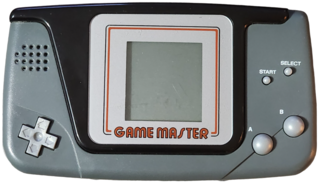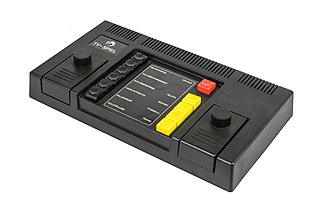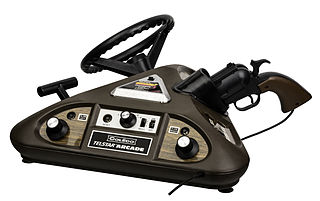
ColecoVision is a second-generation home video-game console developed by Coleco and launched in North America in August 1982. It was released a year later in Europe by CBS Electronics as the CBS ColecoVision.

The Fairchild Channel F, short for "Channel Fun", is a video game console, the first to be based on a microprocessor and to use ROM cartridges instead of having games built-in. It was released by Fairchild Camera and Instrument in November 1976 across North America at a retail price of US$169.95. It was launched as the "Video Entertainment System", but when Atari released its Video Computer System the next year, Fairchild rebranded their machine as "Channel F" while keeping the Video Entertainment System descriptor.

The Atari Game Brain is an unreleased home video game console that was developed and planned for release by Atari in June 1978. It plays 10 particular games, converted from all of Atari's previously released dedicated consoles, such as Pong, Stunt Cycle, and Video Pinball. Its controllers are on the console face, with 4 directional buttons, a paddle, and a fire button. Games are inserted in the top of the system by opening a door that also bears a small instruction booklet.
A dedicated console is a video game console that is limited to one or more built-in video game or games, and is not equipped for additional games that are distributed via ROM cartridges, discs, downloads or other digital media. Dedicated consoles were very popular in the first generation of video game consoles until they were gradually replaced by second-generation video game consoles that use ROM cartridges.

The Color TV-Game is the first video game system ever made by Nintendo. The system was released as a series of five dedicated home video game consoles between 1977 and 1980 in Japan only. Nintendo sold three million units of the first four models: one million units of each of the first two models, Color TV-Game 6 and 15; and half a million units of each of the next two models, Block Breaker and Racing 112. The Color TV-Game series has the highest sales figures of all the first generation of video game consoles.

The IntertonVideo Computer 4000 is an early 8-bit ROM cartridge-based second-generation home video game console that was released in Germany, England, France, Spain, Austria, the Netherlands and Australia in 1978 by German hearing aid manufacturer Interton. The console is quite obscure outside Germany, but many software-compatible systems can be found in numerous European countries. The console is the successor of the Interton Video 3001 and was sold for 298 Deutsche Mark and discontinued in 1983.

The 1292 Advanced Programmable Video System is a second-generation home video game console released by European company Audiosonic in 1978. It is part of a group of software-compatible consoles which include the Interton VC 4000 and the Voltmace Database. The 1292 Advanced Programmable Video System included its power pack inside the console instead of an exterior power pack.
In the history of video games, the first generation era refers to the video games, video game consoles, and handheld video game consoles available from 1972 to 1983. Notable consoles of the first generation include the Odyssey series, the Atari Home Pong, the Coleco Telstar series and the Color TV-Game series. The generation ended with the Computer TV-Game in 1980, but many manufacturers had left the market prior due to the market decline in the year of 1977 and the start of the second generation of video game consoles.

The Game Master is a handheld game console manufactured by Hartung, and designed to compete with the Nintendo Game Boy. In Germany, it was marketed by Hartung itself, while in the UK it was released as the Systema 2000 by the already well-established maker of cheap LCD games Systema. It was also sold a few under alternate names in France, including the Videojet Game Master as well as for a few released by Hartung as the Hartung Super Game and the Hartung Game Tronic. The Game Master has a 64 x 64 monochrome LCD screen.
Unisonic Products Corporation was an American manufacturer and distributor of consumer electronics from the 1970s to the 1990s. Although headquartered in New York City, Unisonic outsourced its manufacturing operations to various facilities in East Asia. Unisonic developed a variety of electronics, including calculators, CRT television sets, video game consoles, digital watches, telephones, answering machines, and digital alarm clocks.
Grandstand is a video game console and electronic game manufacturer and distributor. It was based in the United Kingdom and New Zealand and was active in the 1970s and 1980s.
Magnavox Odyssey is the general brand name of Magnavox's complete line of home video game consoles released from 1972 through 1978. The line includes the original Magnavox Odyssey console, the Magnavox Odyssey series of dedicated home video game consoles, and the Magnavox Odyssey 2 ROM cartridge-based video game console released in 1978. Philips Odyssey is the brand name that includes the Philips Odyssey series of dedicated home video game consoles.

The 1970s was the first decade in the history of the video game industry. The 1970s saw the development of some of the earliest video games, chiefly in the arcade game industry, but also several for the earliest video game consoles and personal computers.
The Philips Tele-Game series was a series of six dedicated first-generation home video game consoles manufactured, released and marketed between 1975 and 1978 by the german company Philips (Magnavox).

The Bildschirmspiel 01 is the only game console that was developed and manufactured in the German Democratic Republic (GDR). It is based on the integrated circuit AY-3-8500 by General Instrument. The gameplay, controls and audiovisual presentation of the four individually selectable games are similar to Pong. The BSS 01 was designed and produced by VEB Halbleiterwerk Frankfurt an der Oder (HFO). Its sales were started in 1979 under the RFT brand at a price of 550 East German marks. Due to a lack of profitability, production was discontinued after just two years. A successor device with more game options and additional colored image output did not pass the prototype stage.

The Interton Video 3000 is a dedicated first-generation home video game console that was released in Germany in 1976 by German manufacturer Interton and sold by Quelle. Due to the AY-3-8500 chipset from General Instrument, the console has six integrated games: Tennis, Football, Practice, Squash, Skeet and Moving target. It had a list price of 198 Deutsche Mark (DM).

The Coleco Telstar Arcade, commonly abbreviated as Telstar Arcade, is a first-generation home video game console that was released in 1977 in Japan, North America and Europe by Coleco. It is the most advanced video game console in the Coleco Telstar series, based on the MOS Technology MPS-7600-00x chips series. Each chip is a microcontroller capable of storing 512 words of ROM.

The Interton Video 3001 is a dedicated first-generation home video game console that was released in 1978 by Interton. It is a Pong clone console and the successor to the Interton Video 3000 and the predecessor of the Interton Video Computer 4000. It could output games in color.

The SHG Black Point is a second-generation home video game console that was released in 1982 by Süddeutsche Elektro-Hausgeräte GmbH & Co. KG only in Germany for 168 Deutsche Mark (DM).














